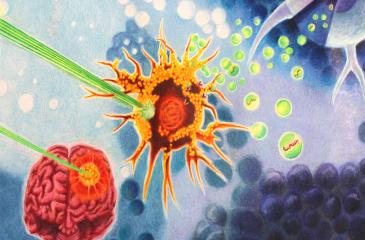University of Minnesota Researchers Study Radiation Resistance in Brain Cancer Cells
Author: Kelly Glynn, Media Relations Coordinator
In a vertical climb to avoid collision with a towering mountain, a plane ejects cargo to gain altitude. Investigators at the University of Minnesota showed that cancer cells perform similar feats in escaping the killing effects of radiation. Their work was published in the May issue of the journal, EBiomedicine.
Radiation is a key component of the standard-of-care treatment for the deadly brain cancer, glioblastoma; however, the treatment is rarely curative. While the growth of glioblastoma cells is often stalled by radiation, tumor growth inevitably resumes in nearly all treated patients.
“Understanding how cancer cells acquire resistance to radiation defines a pathway forward for how we can defeat this cancer,” noted Clark C. Chen, MD, PhD, Lyle French Chair in Neurosurgery and head of the Department of Neurosurgery at the University of Minnesota Medical School.
To understand how glioblastomas become resistant to radiation, the research team led by Chen collected clinical glioblastoma samples from patients prior to and after radiation treatment and compared the levels of microRNAs. MicroRNA is a class of small RNA cells that control how much protein a cell makes, which ultimately determines how the cell functions.
See full release here:
